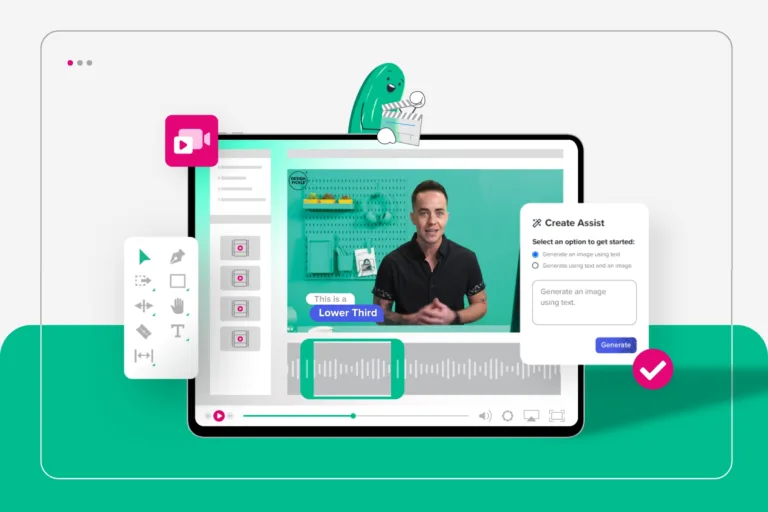If you’ve stumbled upon Design Pickle recently, you may have noticed our fresh new look since our latest website relaunch. If this is your first time visiting us, you might be thinking, “wow! What a beautiful website. I definitely want to use their design services.”
Aw, shucks. We’re blushing!
Although our design service has always been great, our website wasn’t an excellent representation of what we offer and who we are as a company. When I started working here in early 2018, the site was functional but woefully outdated and a bit drab. And if there is any word to describe Design Pickle, it certainly isn’t drab. A creative company named after a gherkin? C’mon!
Flash forward a year later: It’s January 2018, and after months of wireframing, designing, copywriting, revising, and revising some more — we finally relaunch the Design Pickle website. And it was indeed an improvement. It held better content, fancy CSS transitions, and trendier graphics. Although it was better, it was also admittedly very much Frankenstein-ed together. The WordPress theme, much like Frankenstein’s monster, was a beast. It did not play nice with custom code or templated content. If we updated a plugin, the whole thing would crash. It was a constant headache. And it was time for another change.
And so, just months after the initial relaunch, we started the process all over again. Then On December 19 (one day after our live-streamed Request-A-Thon), our new site was born.
Now, if you’ve ever gone through the process of launching (or relaunching) a site, you know it’s a daunting task. It’s time-consuming, exhausting, and often costly. But when done correctly, it could be the best thing for your business. An improved website can improve your engagement, increase leads, and boost your conversions.
Since I’ve somehow survived two website relaunches in the past year, I’d like to offer some critical tips on executing this massive undertaking — so you, too, can join the ranks of hardened marketers with beautiful new sites:
Get By With A Little Help
Our first relaunch was a scrappy one: We didn’t outsource any of the wireframes or design. We jotted down our site map on Google Docs. Almost everything was done in-house; our former marketing director set up the back end, and I toiled away creating mockups for each page. Eventually, we did hire an external developer for the initial build-out, and while talented, he didn’t know or understand our brand. It was merely another design-to-code job for him, so Design Pickle’s unique personality didn’t shine through.
One of the most significant differences between the first relaunch and this most recent one was our decision to hire a seasoned agency to assist with the design and development top to bottom. We didn’t just need a pretty website: We also needed a team to conduct research on our brand, products, and customers.

Hiring or outsourcing can come with its own set of challenges. An agency or freelancer may not always be as available as your internal team, and of course, there are higher costs. But in this instance, Design On Tap was the right choice for us. Their process begins with one crucial element we were missing from the first launch: The carefully crafted buyer journey.
Develop Your Buyer’s Journey
A website relaunch isn’t just a rebrand. While a new look can be refreshing, it won’t necessarily help you achieve your goals, landing you back to the drawing board. And take it from me — you don’t want to do this every few months!
Before you begin any kind of wireframing, you must craft your buyer’s journey: the process your customers go through to become aware of, consider, and decide to purchase your product or service. Here at Design Pickle, we thought we knew our buyer’s journey — but with the addition of several new products, it was time to revisit and optimize.
This process can also be a grueling task but a crucial one. Developing a buyer’s journey is complicated; it can look different for every buyer along the way. But in taking the time to create them, you’ll end up generating more leads and more satisfied customers.

I could write an entirely separate article on the process, but here’s the CliffsNotes version: With Design On Tap’s help, we sent a survey to different cohorts, including current customers and past customers separated by product. The initial review narrowed down to a group of individuals willing to participate in hour-long interviews (yep, that’s right!). It may sound excessive, but gathering information from engaged buyers is vital in developing accurate journeys. Our goal was to better understand who our customers are, what motivates them to sign up, and what kind of language to use to better connect with them.
Post interviews, the team spent over a month analyzing the results and crafting an in-depth journey for each buyer persona. This research became an essential tool in the next step of our redesign.
Related Articles
5 Things to Consider When Rebranding
What We Learned From Building Our Own Ticketing Platform
5 Tips For Website Optimization
Set Your Goals & Priorities
So now we understand our buyers better: But why? Why go through months of data collection? Why even bother with a relaunch in the first place?
If you’re thinking about redesigning your website, you may already know what problems you’re trying to solve. In this instance, be sure to create a strategy that prioritizes your goals before creating any sort of wireframes. Perhaps your site doesn’t attract enough traffic, or you’re not generating enough leads. By pinpointing the exact issues, you can begin to develop your desired outcomes. Establishing goals streamlines the wireframing process and gives you the ability to track your progress and adjust when needed.
In our case, we prioritized increasing the conversion rate, the site speed, and improving the segmented buyer journeys across our different products (among other things!). With these goals in mind, two things happened:
- We were able to hypothesize the needs of the new site and build out wireframes based on these assumptions.
- We now had a handy tool to keep track of our goals, including baseline metrics and experiment tracking.

So now, we have our buyer’s journey, our goals, and wireframes. Then the real fun begins.
Design Your Dream Site
Design is my passion (shocking, I know). And I really love designing websites. But with Design Pickle’s massive growth in 2019, I no longer had the time to stay up all night creating page after page in Photoshop. And after already doing so in early 2018, the thought of starting over again made me feel a little queasy.
Leaning on Design On Tap’s team for the design portion was bittersweet. Most creatives are hesitant to hand off their work — it feels…wrong. When you’ve put so much effort and heart into a project, it’s hard to let it go.
Also, like many creatives, I had grown to hate what I had created. So our first exercise for the design portion was cathartic: We went through all of the significant pages on the original site and pointed out all of the things we hated. Okay — it wasn’t all bad. We also pointed out some of the things we liked. But the process revealed our real desires for a perfect site, and I highly encourage anyone to begin here!

After assessing our current site, we also curated inspiration from other websites we liked and created a wish-list for what we’d love to create. From here, the lead designer created mockups using the insight from our customer research, our goals, and aesthetic preferences. After a few iterations, the new site began to form. And I was in love.
Call The Exterminator
Once the designs were approved, a team of developers began the build-out. A couple of months later, the staging site was nearly complete and ready for review. We were getting close to the finish line; it was both exhilarating and sweat-inducing. Because although your website is almost ready to launch, you have to prepare for the worst. And by the worst, I mean all of those bugs you need to squash.
Design On Tap completed its internal quality review, and then the staged site was handed off to my team for inspection. Skipping this step will cost you: A potential buyer may abandon their cart after a glitchy checkout experience, and leads will leave your site if they’re getting 404 errors everywhere.
Spoiler alert: This is, of course, another lengthy process. You’ll have a lot of pages to comb through (we certainly did), and then there are other factors to consider, such as responsiveness and browser compatibility. Before setting your site live, you’ll need to follow a process for systematizing website quality assurance.

In our case, we listed all of the pages in staging on a spreadsheet and used an excellent website feedback tool called BugHerd to report any issues. BugHerd acts as a virtual layer on top of your site, allowing you to “pin” any elements that need review. It’s easy to use and keeps bug tracking organized. Developers can simply log in to see any pinned issues and fix them directly on the site.
Some common things to look out for when QA-ing your site:
- Browser compatibility: how does your website look across different browsers?
- Screen responsiveness: how does your website function across different devices?
- Dead links or forms: are your links, buttons, and forms working correctly?
- Site speed: Is anything causing slow load time?
- Content quality: Are there spelling mistakes? Consistent punctuation? Missing images?
Prepare For Takeoff
Quality testing is an ongoing process — I’m still finding things here and there that need fixing. So it can be challenging to settle on an actual launch day. It may never feel quite ready to release your new site to the public.
Therefore, you have to be strategic when choosing a launch date. Although you may be excited to show off your stunning new site, don’t jump the gun quite yet: Undiscovered bugs might turn up once you have an uptick in visitors. Your live site may function differently from your staging site.

There are two crucial factors to consider when choosing your launch date: Anticipated traffic and staff on hand. Because things can go astray, be sure to select a day of the week with the least amount of impact on your business. While Fridays sound ideal in this regard, this may result in chaos: launching before a weekend or holiday makes damage control a lot more difficult when key team members are out. You want to have the right people available on launch day, such as IT or developers, to resolve any technical issues that may arise.
In our case, we opted for an early Thursday morning launch, giving us two full days to monitor our new site in the wild. Admittedly, it wasn’t exactly the best timing: Christmas came the following week. So while we anticipated our traffic to be lower (good), the developers were unavailable (bad). Fortunately, most bugs were squashed by the time Santa arrived. But it was certainly a lesson learned.
—
For the most part, we didn’t encounter many issues (except for accidentally triggering a swarm of emails to customers. Sorry, folks!). And we’re continuing to improve the site overall with fresher content and impending micro-interactions. No one gets it right the first day — but thankfully, with the aforementioned goal and priorities, we have a streamlined process for experimentation. Now that the site is live, we’ll continue to run conversion optimization tests to hit those targets.
Launching a new website is a time-consuming challenge, but it’s also a labor of love. After you’ve done it once (or, you know, a couple of times), you’ll undoubtedly learn a lot and hopefully be rewarded with success. There is still more work to come, but I’m proud to say I survived another website relaunch — and it’s all about the journey, not the destination, right?






